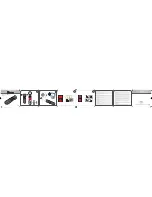
18
Appendix B: Troubleshooting
Q: What do I do if my digital camera will not turn on?
A:
First check the batteries. You need to make sure that they are inserted correctly. Also,
you might want to try another set of batteries in case the ones you are using are low on power
or faulty. Try to turn the camera back on to see if your problems persist.
Q: What do I do if my digital camera got wet?
A:
Turn off your digital camera if it's on. Remove all batteries. Let it dry completely for at least
24 hours before reinserting batteries.
Q: What if the flash on my digital camera doesn't work?
A:
Check that batteries are fresh. Give the flash time to charge before pressing shutter.
Q: If I can't find the pictures I took on my digital camera, what should I do?
A:
Look for the playback camera to view the photos on your camera. Use arrow buttons to
scroll through pictures.
Q: What do I do if my digital camera won't take a picture?
A:
Check that your digital camera is not in playback or review mode. The camera’s memory
may also be full. Download the images to the computer or delete some to make way for new
photos. Check the charge on the batteries. Replace if necessary.
LEAPFROG and the LeapFrog logo are trademarks or registered trademarks of LeapFrog
Enterprises, Inc., used under license. © 2009 LeapFrog Enterprises, Inc. All rights reserved.
19
FCC Statement:
This device complies with the part 15 of the FCC rules. Operation is subject to the following
two conditions:
(1) This device may not cause harmful interference, and
(2) This device must accept any interference received, including interference that may cause
undesired operation.
Caution:
Changes or modifications not expressly approved by the party responsible for
compliance could void the user's authority to operate the equipment.
NOTE:
This equipment has been tested and found to comply with the limits for a Class B
digital device, pursuant to Part 15 of the FCC Rules; these limits are designed to provide
reasonable protection against harmful interference in a residential installation. This equipment
generates. Uses and can radiate radio frequency energy and, if not installed and used in
accordance with instructions may cause harmful interference to radio or -television reception,
which can be determined by turning the equipment off and on, the user is encouraged to try to
correct the interference by one or more of the following measures:
__ Reorient or relocate the receiving antenna.
__ Increase the separation between the equipment and receiver.
__ Connect the equipment into an outlet on a circuit different from that to which the receiver is
connected.
__ Consult the dealer or experienced radio/ TV technician for help.




























